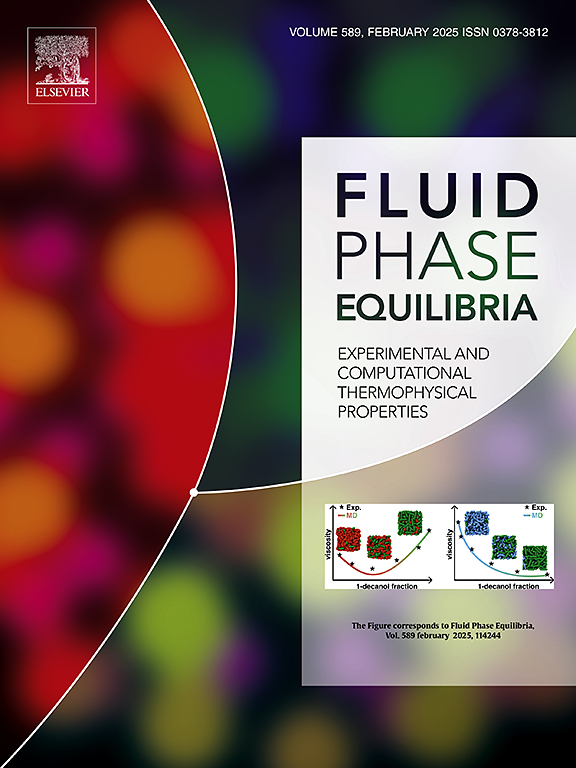A theoretical model of gas-liquid phase transition near the critical point
IF 2.7
3区 工程技术
Q3 CHEMISTRY, PHYSICAL
引用次数: 0
Abstract
In this study, the internal pressure strength term in the Van der Waals multiphase interface equation has been adjusted to better fit the interface region. By applying the principle of normal isopressure, we can ascertain the thickness of the gas-liquid interface and the material's density distribution along the normal direction. At the gas-liquid interface, molecules experience both an attractive force pulling them into the liquid and a repulsive force from collisions with the gas. By considering the combined effect of these two forces, we can derive an expression for the latent heat of evaporation that includes the molecular volume parameter b, using the normal path integral. This expression is capable of predicting the latent heat of evaporation for substances like water, ranging from the boiling point to the critical point. The maximum deviation for conventional substances is under 30 %, while the prediction error using the Boltzmann distribution ranges from 40 % to 60 %. After introducing the dimensionless parameter τc, the maximum prediction deviation for H2O drops to below 8 %, significantly enhancing the prediction accuracy for other substances as well. For subcritical temperatures (Tc-3 K < T< Tc), the new expression successfully predicts the latent heat of evaporation for over 30 substances, with an error margin of no >1 %. Additionally, it predicts the critical volume of a substance with a deviation of no >2.4 %. Thus, the latent heat of evaporation expression that incorporates molecular volume parameters demonstrates excellent predictive capability in the gas-liquid phase transition process near critical temperatures, providing a foundation for advancing the average field theory of gas-liquid phase transitions for various substances at near-critical temperatures.
临界点附近气液相变的理论模型
本研究对范德华多相界面方程中的内压强度项进行了调整,以更好地拟合界面区域。利用法向等压原理,可以确定气液界面的厚度和材料在法向上的密度分布。在气液界面,分子既受到将它们拉入液体的吸引力,又受到与气体碰撞产生的排斥力。通过考虑这两种力的综合作用,我们可以利用法向路径积分推导出包含分子体积参数b的蒸发潜热表达式。这个表达式能够预测像水这样的物质的蒸发潜热,范围从沸点到临界点。常规物质的最大偏差在30%以下,而使用玻尔兹曼分布的预测误差在40%到60%之间。引入无量纲参数τc后,对H2O的最大预测偏差降至8%以下,对其他物质的预测精度也显著提高。对于亚临界温度(tc - 3k <;T<Tc),新表达式成功地预测了30多种物质的蒸发潜热,误差不超过1%。此外,它预测物质的临界体积偏差不超过2.4%。因此,包含分子体积参数的蒸发潜热表达式在临界温度附近的气液相变过程中表现出良好的预测能力,为推进各种物质在近临界温度下气液相变的平均场理论奠定了基础。
本文章由计算机程序翻译,如有差异,请以英文原文为准。
求助全文
约1分钟内获得全文
求助全文
来源期刊

Fluid Phase Equilibria
工程技术-工程:化工
CiteScore
5.30
自引率
15.40%
发文量
223
审稿时长
53 days
期刊介绍:
Fluid Phase Equilibria publishes high-quality papers dealing with experimental, theoretical, and applied research related to equilibrium and transport properties of fluids, solids, and interfaces. Subjects of interest include physical/phase and chemical equilibria; equilibrium and nonequilibrium thermophysical properties; fundamental thermodynamic relations; and stability. The systems central to the journal include pure substances and mixtures of organic and inorganic materials, including polymers, biochemicals, and surfactants with sufficient characterization of composition and purity for the results to be reproduced. Alloys are of interest only when thermodynamic studies are included, purely material studies will not be considered. In all cases, authors are expected to provide physical or chemical interpretations of the results.
Experimental research can include measurements under all conditions of temperature, pressure, and composition, including critical and supercritical. Measurements are to be associated with systems and conditions of fundamental or applied interest, and may not be only a collection of routine data, such as physical property or solubility measurements at limited pressures and temperatures close to ambient, or surfactant studies focussed strictly on micellisation or micelle structure. Papers reporting common data must be accompanied by new physical insights and/or contemporary or new theory or techniques.
 求助内容:
求助内容: 应助结果提醒方式:
应助结果提醒方式:


